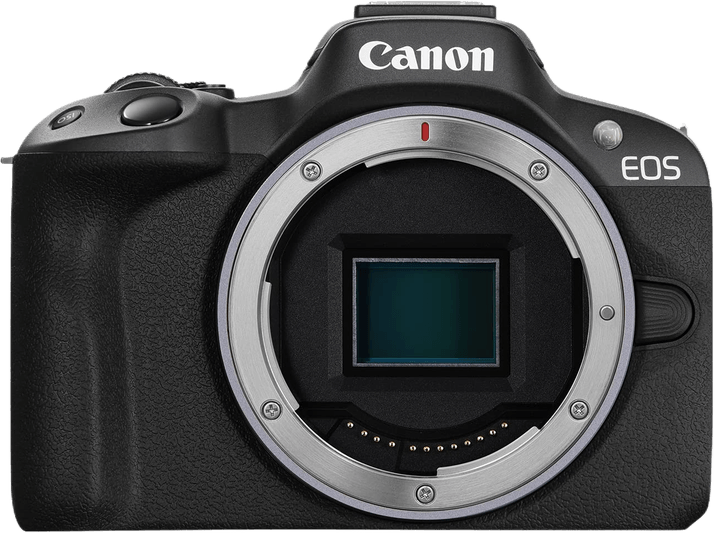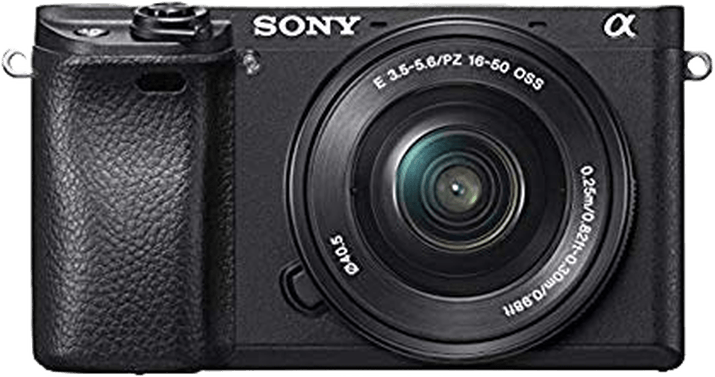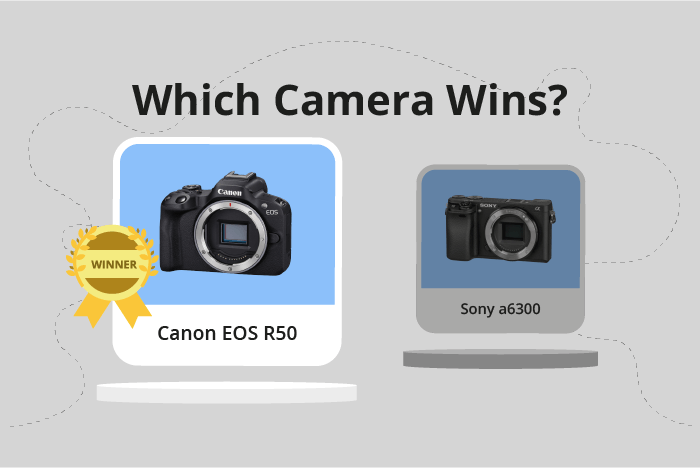Canon EOS R50 vs Sony a6300 Comparison
Canon EOS R50

Sony a6300

The Canon EOS R50 outperforms the Sony a6300 with a score of 70/100 compared to 61/100. Both cameras are mirrorless and share similarities in their general specifications. However, the Canon EOS R50 is the superior camera in terms of its overall performance.
The Canon EOS R50 is lighter, weighing 375g, while the Sony a6300 weighs 404g. This makes the Canon EOS R50 more comfortable and easy to carry around. Moreover, the Canon EOS R50 has a more recent release year (2023) compared to the Sony a6300 (2016), indicating better technology and features.
On the other hand, the Sony a6300 is smaller in size with dimensions of 120 x 67 x 49mm, making it slightly more compact than the Canon EOS R50 (116 x 86 x 69mm). However, the Sony a6300’s higher launch price of $1000 compared to the Canon EOS R50’s $679 makes it less appealing to budget-conscious consumers.
Taking all factors into account, the Canon EOS R50 emerges as the better camera due to its higher score, lighter weight, and more affordable price. While the Sony a6300 has its advantages in size, the Canon EOS R50 offers better value for money and overall performance.
Canon EOS R50 vs Sony a6300 Overview and Optics
The Canon EOS R50 outperforms the Sony a6300 in optics, scoring 73/100 compared to the a6300’s 68/100. Both cameras share similarities in specifications, such as 24 and 24.2 megapixels, CMOS sensor type, APS-C sensor size, and lack of image stabilization. However, the differences in their respective processors, lens mounts, and DXOMARK scores contribute to the gap in their optics performance.
The Canon EOS R50’s superior optics can be attributed to its Digic X processor, which enables faster and more reliable image processing. Additionally, the R50’s lens mount, the Canon RF, offers a wider range of high-quality lenses, leading to better overall image quality. The R50 also boasts a higher DXOMARK score of 94 for the sensor, compared to the a6300’s score of 85, indicating a better sensor performance.
On the other hand, the Sony a6300 has a slightly higher shooting speed of 11 frames per second (fps), compared to the R50’s 12 fps. While this difference is minimal, it may provide an advantage for capturing fast-moving subjects. The a6300’s lens mount, the Sony E, is compatible with a broad range of lenses, though it may not offer the same level of quality as the Canon RF mount.
Taking these factors into account, the Canon EOS R50 proves to be the superior camera in terms of optics, with a better processor, lens mount, and sensor performance. However, the Sony a6300 does not fall far behind and may still be a suitable choice for those prioritizing shooting speed and lens compatibility.
Canon EOS R50 vs Sony a6300 Video Performance
The Canon EOS R50 and the Sony a6300 both excel in video capabilities, earning an identical score of 91 out of 100. These cameras share numerous video specifications, including a maximum video resolution of 4K and dimensions of 3840 x 2160. Additionally, both cameras have a maximum video frame rate of 120fps and offer built-in time-lapse functionality.
Despite the tied scores, the Canon EOS R50 has some advantages over the Sony a6300. The EOS R50 benefits from Canon’s renowned color science, which provides more accurate and pleasing colors in videos. Furthermore, the R50’s autofocus system is more advanced, ensuring sharp and consistent focus tracking during video recording. This feature is particularly useful for vloggers, documentary filmmakers, and content creators who need reliable autofocus performance.
On the other hand, the Sony a6300 has its own strengths. It is known for its exceptional low-light video performance, capturing cleaner footage in dimly lit environments. This capability is valuable for filmmakers shooting in challenging lighting conditions or those who prioritize low-light performance in their work.
In comparing the video capabilities of the Canon EOS R50 and the Sony a6300, it is clear that both cameras offer impressive features. While the R50 stands out for its color science and autofocus system, the a6300 excels in low-light video performance. Ultimately, the choice between these two cameras depends on the specific needs and preferences of the user. Both cameras are strong contenders in the realm of video, offering high-quality footage and a range of useful features.
Canon EOS R50 vs Sony a6300 Features and Benefits
The Canon EOS R50 outperforms the Sony a6300 with a feature score of 72/100 compared to the Sony’s 54/100. Both cameras share some common specifications such as a 3-inch screen size, flip screen, lack of GPS, and WIFI connectivity. However, the Canon EOS R50 excels in certain areas, making it the superior choice in terms of features.
The EOS R50 has a higher screen resolution of 1,620,000 dots, providing a clearer and more detailed image preview. In contrast, the a6300 has a screen resolution of 921,600 dots. The Canon EOS R50 also includes a touchscreen, making it more user-friendly and efficient for menu navigation and focus adjustments. The Sony a6300 lacks this feature.
Furthermore, the Canon EOS R50 comes with Bluetooth connectivity, allowing for seamless file transfers and remote control options. The Sony a6300 does not include Bluetooth capabilities. This advantage gives the Canon camera more convenience and versatility in terms of file sharing and remote operation.
On the other hand, the Sony a6300 shares some advantages with the Canon EOS R50, such as the flip screen feature, which is useful for vlogging or capturing images from different angles. However, the lack of touchscreen and Bluetooth capabilities puts it at a disadvantage compared to the Canon EOS R50.
Considering the higher feature score and the various advantages mentioned, the Canon EOS R50 proves to be the better choice for photographers seeking a camera with more advanced and user-friendly features. While the Sony a6300 shares some similarities, it falls short in crucial areas, making the Canon EOS R50 the more desirable option.
Canon EOS R50 vs Sony a6300 Storage and Battery
The Canon EOS R50 outperforms the Sony a6300 in storage and battery with a score of 35/100 compared to the Sony’s 24/100. Both cameras have one memory card slot and accept SD, SDHC, and SDXC cards. However, the Canon EOS R50 is compatible with UHS-I and II cards, providing faster read and write speeds.
The Canon EOS R50 has a battery life of 370 shots, using the LP-E17 battery type, and offers USB charging. The Sony a6300 has a slightly longer battery life of 400 shots with the NP-FW50 battery type but lacks USB charging. Despite the longer battery life, the Sony a6300’s lack of USB charging limits its convenience and flexibility for on-the-go users.
In terms of storage and battery, the Canon EOS R50 has an advantage with its UHS-I and II compatibility and USB charging feature, making it a better choice for users seeking faster performance and convenience. The Sony a6300’s marginally longer battery life is not a significant advantage to outweigh the benefits offered by the Canon EOS R50 in this category.
Canon EOS R50 vs Sony a6300 – Our Verdict
Are you still undecided about which camera is right for you? Have a look at these popular comparisons that feature the Canon EOS R50 or the Sony a6300:

